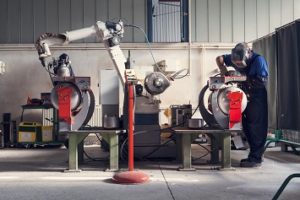Industrial robots come in two major types: fixed robots that work from a fixed platform and mobile robots that move around the workplace. Both kinds of robots can pose hazards to humans. For fixed robots, the hazard is typically controlled by physical guards that prevent humans from entering the robot’s swing radius or point of operation. For mobile robots, the solution often involves carefully controlling the robot’s movement so as not to endanger humans.
But what if you were to take a robot arm—of the type typically mounted on a fixed base and closed in with Plexiglas or safety fencing—and put it on a mobile mount? And what if that mobile mount could move freely throughout your facility rather than moving along a magnetic track or navigational beacon system imbedded in the floor? Free-ranging, multifunctional robots offer a leap into the future for utility—but they pose a whole new set of safety concerns for the humans who work alongside them.
To address safety concerns for the next generation of industrial robots, the Robotic Industries Association (RIA), an industry trade group, is working both with consensus-standard-setting organizations and regulators.
A New Alliance
On October 6, the Occupational Safety and Health Administration (OSHA) and the National Institute for Occupational Safety and Health (NIOSH) signed an alliance partnership agreement with the RIA. The OSHA/NIOSH/RIA Alliance will enable the agencies and the industry to share expertise and knowledge about safety practices and will focus on communication and education about best practices in robot safety.
One of RIA’s stated goals for the alliance is to enhance OSHA’s and NIOSH’s technical expertise about robotics. It’s about time: OSHA’s guidelines for robotics safety were published in 1987; the chapter in the OSHA Technical Manual dedicated to Industrial Robots and Robot System Safety was published in 1999. NIOSH’s publication no. 85-103, Preventing the Injury of Workers by Robots, is even older—it dates from December 1984. So, clearly, the relevant government agencies are a little behind the times.
In addition to bringing OSHA and NIOSH into the 21st Century, the alliance intends to improve awareness of workplace hazards associated with both traditional industrial robots and the emerging technology of human robot collaboration (HRC) installations and systems. Unlike the robotics of 20 years ago that relied on separating human and robot workspaces to keep humans safe, these systems enable humans and robots to work together to perform tasks within the same workspace. The alliance will identify research that may be needed to help reduce workplace hazards that result from HRC processes.
Because OSHA and NIOSH are involved in the alliance, its ultimate focus will be on worker safety. Alliance members will jointly develop training tools, resources, and materials for use in worker training. In addition, members will identify and share methods for controlling exposure to industrial robot hazards. Materials, information, and resources developed as part of an alliance are made publicly available for free.
Other Initiatives
The alliance is not RIA’s only effort at improving robotics safety. Tomorrow, we’ll look at RIA’s role in developing consensus standards published by the American National Standards Institute.

